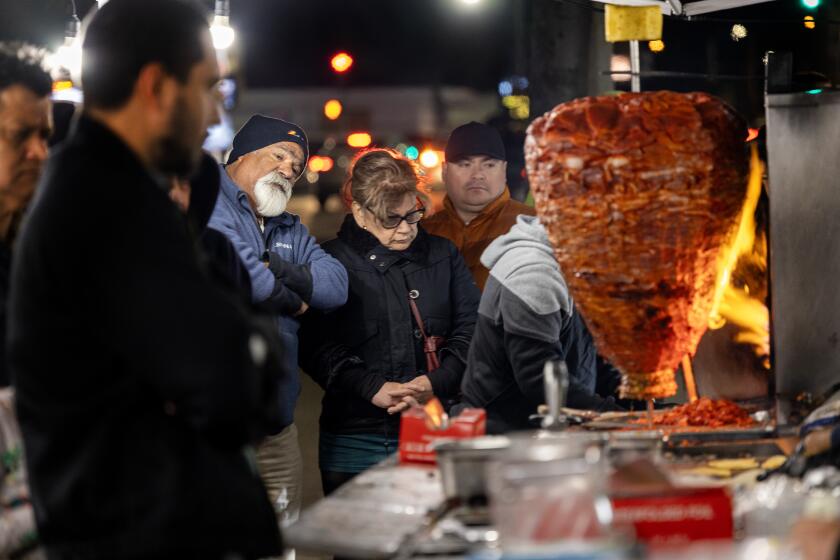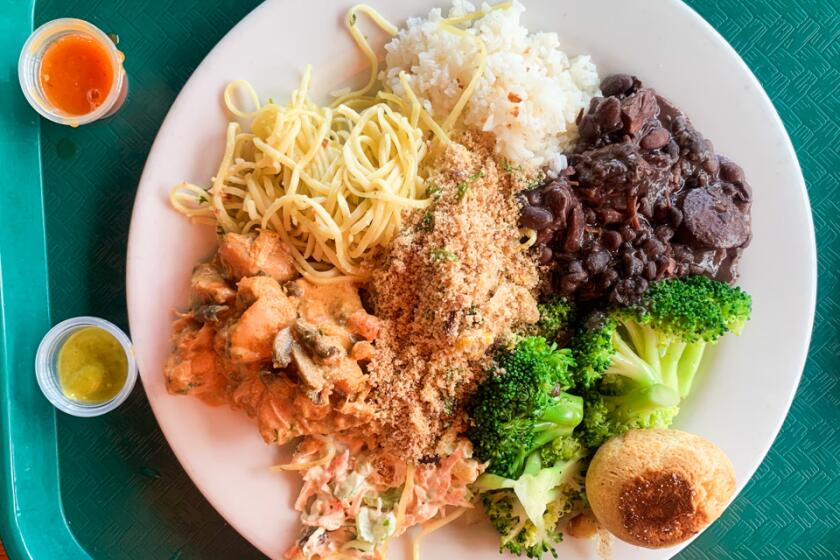Spicy Reading : Revised American...
Forerunners of this cookbook trio have been mainstays in American households for decades. Generations of cooks have turned to them for basic information and tried and true recipes.
Revisions of two of these classics, and a third book that follows in the footsteps of “The Good Housekeeping Illustrated Cookbook,” have been published this season. Cookbooks such as these are certainly not avant-garde; they don’t contain recipes on the cutting edge of today’s food trends. Our evaluation concluded, however, that each volume has valuable, and different, attributes.
Of the three books, “Betty Crocker’s 40th Anniversary Edition Cookbook” provides the most complete nutrition information for its more than 1,000 recipes. A calorie count is included at the end of each recipe, and a full analysis at the close of the chapter.
All recipes have been tested in the Betty Crocker Kitchens. Photographs of 200 recipes are included, along with additional line drawings to simplify new procedures or help identify foods.
An effort has been made to lighten classic recipes by reducing fat, sugar and sodium, and the book encourages the use of fresh ingredients. Information on microwaving and grilling have been expanded from previous editions; food safety information has been updated to include the newest guidelines on how to prepare and cook meats and eggs safely.
In an attempt to address the needs of today’s busy lifestyles, each chapter includes a list of “Fix-It-Fast” tips. In addition, recipes that can be prepared in 30 minutes or less have been designated by a clock symbol.
The “Cooking With Confidence” section offers a glossary of terms and information on setting up a kitchen and measuring ingredients. “Special Helps” includes a variety of assistance aids, along with charts on refrigerator and freezer storage and how to select and use herbs, spices and seeds.
With a color index that includes photographs of all the book’s recipes and more than 1,500 step-by-step drawings, “The Good Housekeeping Illustrated American Cookbook” certainly lives up to its name. It also outshines either of the other two books in this regard.
Each photo in the 64-page color gallery includes a caption describing the dish, how many servings it yields, preparation time and where it appears in the book. By scanning this section you can plan a menu that not only appeals to the eye but meets personal scheduling demands.
The trade-off is fewer recipes--600 vs. more than 1,000 in each of the other books. Nutritional information in this volume is limited to the calorie count for each recipe.
Every recipe has been triple-tested by home economists at Good Housekeeping. According to the introduction, the recipes have been selected to reflect people’s current concern with health--”counting calories, reducing their intakes of red meat, fat and processed foods, and trying to add more fish, poultry, vegetables and grains to their daily diet.”
There has definitely been an attempt to incorporate lighter, more up-to-date recipes such as braised endive and radicchio, herbed goat cheese with sun-dried tomatoes and Southwestern favorites. We did notice, however, that quesadillas are mistakenly called quesados.
The tip boxes scattered throughout the recipe section offer garnishing ideas, information on handling ingredients or equipment, and ways to make preparation easier. Other beneficial features are the regionally themed special-occasion menus, which include preparation timetables and tips on presentation.
The subtitle of “The New Settlement Cookbook”--”The First Classic Collection of American Ethnic Recipes”--clearly points up this book’s strongest feature. You won’t find recipes for gefilte fish, kasha or pierogi in either of the other volumes.
This is a revised and updated version of the book that has sold more than 2 million copies since the first edition was published in 1901. The goal, as stated in the introduction, was “to retain the charm while making the book a more useful tool for modern homemakers.”
Recipes in the original book were divided into two sections. Those in the first part came from cooking classes offered by the Milwaukee Keep Klean Mission, a community organization established to help immigrants, mostly from Eastern Europe, learn about American life and American ways. A second section contained heirloom recipes, reflecting the different heritages of those involved in what came to be called “The Settlement.”
The new edition retains many of these heritage recipes, but it has been expanded to include some from other parts of the country. We take exception, however, to the refried bean recipe that calls for kidney beans rather than pinto beans.
The emphasis of the book is on basic techniques, expanded by variations. Thus we see braised chicken, followed by coq au vin , chicken fricassee and braised curried chicken legs.
Attention has been given to incorporating the use of new kitchen equipment, such as the food processor and microwave oven--”wherever it might be useful,” explains the introduction. The book stops short, however, of adapting classic recipes. This task, the editor states, is “outside the jurisdiction of this revision. Instead, we’ve made an attempt to use the microwave where applicable, if only in a very general way.”
The book also emphasizes healthy eating in the recipes that have been added. “Some of the heirloom recipes have been revised to omit the unnecessary enrichment of eggs, cream and butter,” notes the editor. However, he also explains that “Stick-to-your-ribs fare has been the foundation of this book. We cannot adapt this kind of old-fashioned goodness into a diet book.”
This book is the weakest of the three in illustrations--there are no photographs and only a few line drawings. Nutrition information is limited to a table giving very general calorie counts; there is no analysis of the recipes.
A chapter on Making Your Kitchen Work for You includes practical information on meal planning, kitchen equipment, how to remove common stains and the proper way to set a table, along with retaining novel items such as how to make soap and start a wood and coal fire.
More to Read
Eat your way across L.A.
Get our weekly Tasting Notes newsletter for reviews, news and more.
You may occasionally receive promotional content from the Los Angeles Times.






